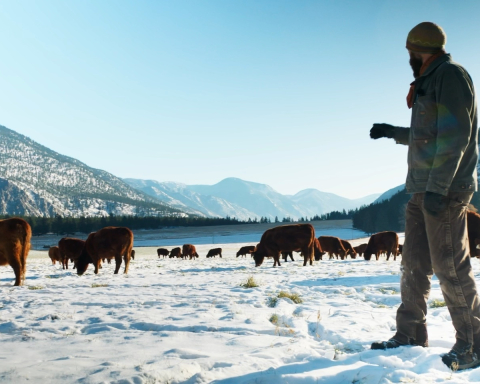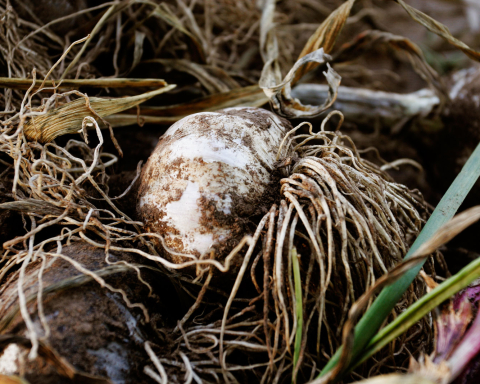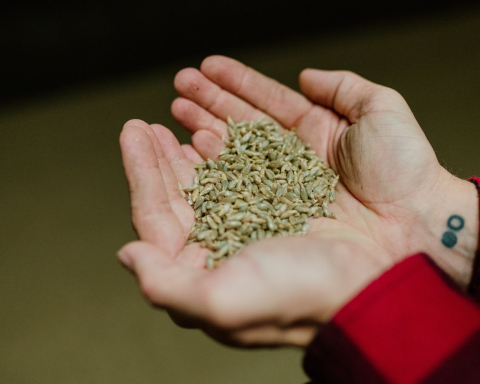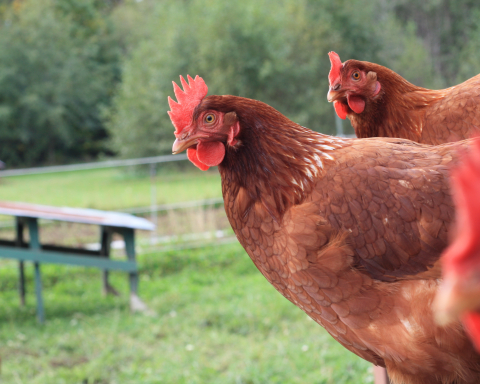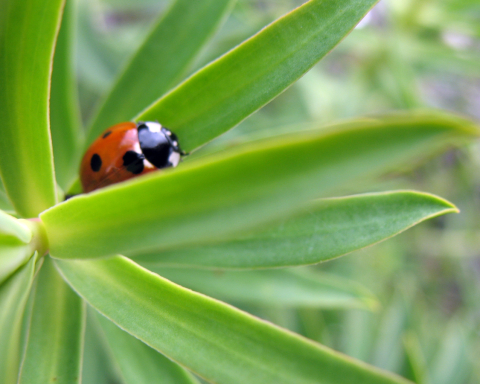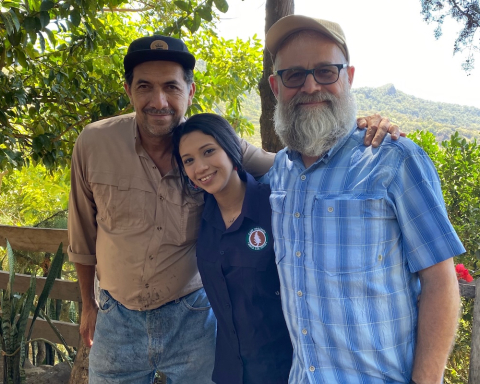Corine Singfield
A Perspective on Pigs and Chickens
I could not imagine farming without the help of animals again.
As a young urban farming city slicker, I longed to homestead somewhere in the woods far away. I moved to the Great Bear Rainforest to start a new farm. We had no money to buy a tractor. As it turns out, a small rototiller is not a suitable tool to break down a freshly de-stumped and compressed forest floor. In his milestone book The Self-Sufficient Life and How to Live It, John Seymour writes “experience shows that for bringing grassland into cultivation either the plough, or the pig’s snout, is essential.”
An enthusiastic neighbour with pigs who had jokingly put out a “Hog for Rent” sign on his barn was coaxed into lending us five of his pigs for the task of turning the field into seedable earth. After two months of intensive rotational grazing, the pigs had cleared 1.5 acres and turned it into the basis of our market garden. They pulverized the quack grass and their powerful snouts tore through cottonwood roots.
We learned that it is critical to run some tests as to determine the perfect size of the rotational moving pen and the optimum time between moves. Leave them for too long and they will dig craters; not enough time and they will not have turned enough dirt. If the area is too big they will get picky with where they are rooting so a smaller pen ensures a more uniform job. We ended up splitting the 1.5 acre area into eight zones, moving them every week.
Many things come into play when making that decision: size and number of pigs, palatability of the ground cover, quality of the soil and the quantity of feed that you are giving them. Some farmers insert grains in a deep hole on the side of stumps. Pigs will go to great lengths loosening the soil in an attempt to retrieve the golden sweet oats.
Animals are central to operating a small closed loop farm where nutrients are produced and cycled on site to a level that does not exceed the carrying capacity of soil and thus prevents leaching into water sources. It is a cycle on which all food that we grow depends and it is a system that has fed humans for generations.
When managed properly, livestock can save farmers endless amounts of time by simplifying tasks like weed management, soil preparation, disease control, and post-harvest cleanup while being true portable composting machines.
After our success clearing the land with pigs, it felt like a natural next step to introduce pigs and chickens into our crop rotations. We started using the pigs to clean up after a potato harvest to ensure that there weren’t any volunteers carrying disease or insects for the following year. The pigs fertilize and till the soil making it ready for broadcasting a winter cover crop. A pig rotation can be used to break down and integrate plant biomass into the soil without compaction.
Harnessing the power of the pig’s snout or the scratching of chicken feet reduces the need for using a tractor and helps to preserve the soil’s structure, tilth and food web.
Harnessing the power of the pig’s snout or the scratching of chicken feet reduces the need for using a tractor and helps to preserve the soil’s structure, tilth and food web. Chickens can be used to mow the orchard, doing away with the tedious job of weed whacking around each tree. They can also be sent in right after the pigs to control flies or other insects. Moving your livestock around the farm increases your farm’s total herd carrying capacity.
Planning for Livestock
In order to integrate animals into your crop rotations you will need to move them. Try to imagine pathways for the moves. While chickens can be moved quite easily from one end of the farm to another with the help of a coop on wheels, pigs are much more easily moved on their own hooves. It helps to include your animal rotations right into your farm plan. If you wanted to use your pigs to clean up and prep the soil after harvest you could plan for the crops to ripen in succession from one end to the other of the field and have your pigs follow that direction. Pigs are not compatible with permanent raised bed so if that is your method of choice, you will want to go with chickens or ducks that have a lesser impact.
You also need to allow for enough time between the presence of livestock and harvest. Organic standards call for four months between soil’s contact with raw manure and harvest. If crops that accumulate nitrates are to be grown, the raw manure must be applied at least four months before these crops are planted. Nitrate-accumulators include brassicas, leafy greens, beets, and chard; raw manure must be applied in moderate amounts and the soil must be warm and moist.
Other things to consider are the type of soil, compaction levels, future crop plans, and the nutritional value of the crop. The perfect timing for your soil management plan might not be the same as for the maturity of forage.
Your end goal will determine which forage you will plant for your livestock. If it is to make the soil cultivable, you can choose deep root crops such as turnips, Jerusalem artichokes, potatoes, or fodder beets. If controlling weeds is a priority then less palatable grasses are best to encourage livestock to go for the weeds instead. To boost fertility, go with a mix that contains legumes.
Livestock Basics: Keeping Your Animals Happy and Healthy
Raising animals presents challenges that multiply the laws of unpredictability in farming by a few fold. They don’t always stay where you want them to stay. They can get sick or get into trouble. An emergency with livestock will always take precedence over a critical task in the veggie garden. They can save you time or cost you a lot. Make sure that you have contingency plans.
Raising animals presents challenges that multiply the laws of unpredictability in farming by a few fold.
Water
Livestock need fresh water at all time. Pigs are especially talented at flipping or destroying their watering apparatus. We like to use a bath tub with reinforced sides but even then you’ll end up finding one pig laying in it enjoying the remaining inch of muddy water from time to time. You’ll need to transport their water with each move.
Feed
Animals that have access to pasture are less prone to diseases and have higher levels of omega-3 fatty acids in their meat, and more vitamin E than animals raised in confinement. They are also happy. A happy animal is one that gets to live according to its true nature: a pig loves rooting in fresh dirt, a chicken loves scratching and pecking.
Feed requirements depend on the animal. In the case of grain eating omnivores – poultry and hogs primarily – they will need unlimited access to a species specific, balanced ration that includes minerals. You can supplement the rations with pasture, crop residues, and weeds while keeping in mind that no one type of pasture will consist of a complete diet. Pigs are monogastric, meaning that they don’t derive protein from eating grass like ruminants. They can’t survive on a diet of grass and greenery and still need to be fed grains even if they are cleaning up the veggie patch after harvest.
Pigs are naturally attracted to higher protein crops such as clover, alfalfa or field peas. Planting a few acres of peas for them allows to cut feeding costs significantly. For every 4 kg of alternative feed (weeds, beets, potatoes, etc.) that you give your pigs, you can reduce their ration by a 1 kg. If you want your pigs and chickens to thoroughly mow or clean up an area that is less palatable you can temporarily reduce their ration to induce a feeding frenzy. We like to mix oats and field peas as forage for the pigs. For a quicker turn around we use a few dense buckwheat plantings in a row and send the animals more often.
Shelter, Fencing
You will become an expert in all things electric fence related. E-fences are extremely simple to use when done properly, but you have to make sure that they are clear of obstructions, such as vegetation that can “ground” the power and weaken your fence. An overlooked detail with an electric fence can cost you a crop at the hands of pigs or an attack by predators. Almost every morning we find new traces of a coyote visit around the chicken pen. The electric fence works very well…when connected correctly.
You will need a few moveable electric mesh fences, a deep cycle battery, a fence charger, and a power source such as a small solar panel. A sense of humor and the willingness to wrangle the odd escapee from time to time can also come in handy.
Light and durable pens must be transported everywhere. A chicken tractor is perfect for hens that return to their roost at night, so they can be transported to a new location before they awaken the next day. We use a small and simple slanted roof shelter made of recycled materials for the pigs. It can be moved small distances with 2 people or lifted with the tractor. Pigs don’t have sweat glands and cannot cool themselves so they must always have access to moist soil and shade.
Learning and Growing with Livestock
At the Tsawwassen First Nation Farm School where I currently dabble in the joys of farming, we plan on acquiring two flocks of chickens, some ducks, and about 30 pigs next spring. We are very excited to conduct experiments using chickens to mow the orchard, determining stocking rates, suitable feeding regimens, and optimal pen size. Similar experiments will be conducted with the pigs. I look forward to streamlining and simplifying my work as a farmer with the integration of livestock. Tune in next year – I’ll be eager to report on what we have learned!
Corine Singfield is the Farm Manager and Farm School Coordinator of the Tsawwassen First Nation Farm School, a collaboration project with the Institute of Sustainable Food Systems at Kwantlen Polytechnic University. The TFN Farm School is a 10 month practical program to learn how to farm and start a farm business. www.kpu.ca/tfnfarm.ca



